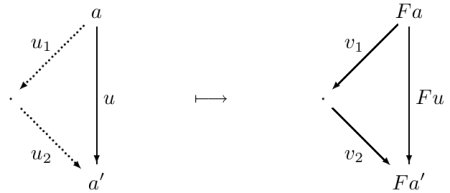Pullback-homomorphisms
Posted by Tom Leinster
Matías Menni and I have been having some interesting conversations about notions of Möbius inversion in categories, prompted by his talk at Category Theory 2010, his recent paper with Bill Lawvere, and my paper a while ago on Euler characteristic of categories.
This post is about an offshoot of our conversation. It solely concerns some very standard notions of category theory. Take a monad on some category. A -algebra is, of course, an object together with a map satisfying some axioms, and a map of -algebras is a commutative square Call a pullback-homomorphism if this square is a pullback.
How should we think about pullback-homomorphisms? What properties do they have? Are they a useful notion? (And is there a better name?)
Surely, surely, someone has looked into this before. Does anyone know anything about it?
You can get a feel for pullback-homomorphisms by working out what they are for various familiar monads . The rest of this post will be a bunch of examples of this type. One of them will be the example that led me into this, related to Möbius inversion.
Groups Let’s begin with the free group monad on . We have a group homomorphism , and the question is whether the square above is a pullback. That would mean:
for every and every word in that evaluates to , there is a unique word in that evaluates to and satisfies .
For example, this says that for every and such that , there exist unique such that , , and .
In particular, we can take . For every we have , so there exist unique such that , , and . It follows quickly that is bijective, that is, an isomorphism. And for any monad, every isomorphism is a pullback-homomorphism.
So, for the group monad, the pullback-homomorphisms are just the isomorphisms.
Vector spaces, modules, Lie algebras, … The same goes for any monad on that, thought of as a theory, contains the theory of groups. The pullback-homomorphisms are just the isomorphisms.
(You can pare it down further: e.g. the same argument also works whenever the theory contains a constant and a ternary operation satisfying the equation — a ‘one-sided Mal’cev operation’.)
-sets Fix a group and let be the monad on . A map of -sets is a pullback-homomorphism if and only if:
for all , and such that , there exists a unique such that and .
This always holds: you can and must take .
So for -sets, every homomorphism is a pullback-homomorphism.
In the examples so far, the notion of pullback-homomorphism has been trivial in one sense or the other. It’s either included everything or (essentially) nothing. But in the next example, the notion is non-trivial.
Functors Take a small category and a category with pullbacks and small coproducts. Then the functor category is monadic over . Explicitly, the monad is given by (, ).
A -algebra is a functor . A map of -algebras is a natural transformation. And it can be shown that a natural transformation is a pullback-homomorphism if and only if it is cartesian, that is, its naturality squares are pullbacks.
The previous example (-sets) is a special case. When is a groupoid, every natural transformation between functors out of is cartesian. This is why every map of -sets is a pullback-homomorphism.
Pointed sets Take the monad on , whose algebras are pointed sets. The category of algebras is equivalent to the category of sets and partial functions. Under this equivalence, the pullback-homomorphisms correspond to the total functions.
So, the category of -algebras and pullback-homomorphisms is equivalent to . I think the same is true of the monad for any set .
Sup-lattices Take the powerset monad on . A -algebra is a sup-lattice, that is, a poset with all joins. A homomorphism is a join-preserving map. If my calculations are correct, a homomorphism is a pullback-homomorphism if and only if it embeds as a downwards-closed subset of .
Categories This is the example that started me thinking about this. Take the free category monad on the category of directed graphs. A -algebra is a category, and a homomorphism of -algebras is a functor.
It’s not too hard to show that a functor is a pullback-homomorphism if and only if it has unique lifting of factorizations. This means:
given a map in and a factorization in , there is a unique pair of maps in such that , , and .
(You might expect this condition on binary composition to be accompanied by a condition on nullary composition, i.e. identities. But in fact that nullary condition comes for free.)
Having unique lifting of factorizations (ULF) is a crucial property in the study of Möbius categories, as Lawvere and Menni’s paper shows. It was in an effort to understand this property that I started thinking about pullback-homomorphisms. On page 230 they say that ‘the definition of ULF-functor should be compared with that of local homeomorphism’. I don’t know how literally to take this, but it made me consider the next (and final) example:
Compact Hausdorff spaces Let be the ultrafilter monad on , whose algebras are compact Hausdorff spaces. What are the pullback-homomorphisms? I don’t know.


Re: Pullback-homomorphisms
Unrolling the compact Hausdorff space example, pullback homomorphisms imply a reflection of limits-type property. Let be a pullback homomorphism from to .
For any ultrafilter in , if there is some such that , then there exists a unique in such that and .
I’m not much of a whiz with filters, but I suspect this property coincides with something pretty familiar, like being open.